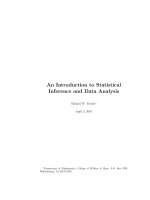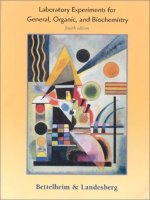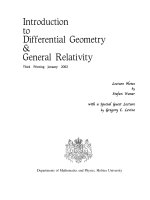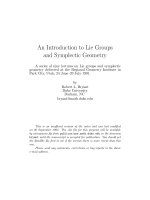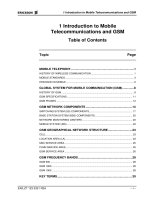Laboratory Experiments for Introduction to General, Organic and Biochemistry docx
Bạn đang xem bản rút gọn của tài liệu. Xem và tải ngay bản đầy đủ của tài liệu tại đây (2.43 MB, 569 trang )
Harcourt, Inc. Experiment 1 1
Experiment 1
Laboratory techniques: use of the laboratory
gas burner; basic glassworking
Background
The Laboratory Gas Burner
Tirrill or Bunsen burners provide a ready source of heat in the chemistry laboratory. In
general, since chemical reactions proceed faster at elevated temperatures, the use of heat
enables the experimenter to accomplish many experiments more quickly than would be
possible at room temperature. The burner illustrated in Fig. 1.1 is typical of the burners
used in most general chemistry laboratories.
Violet outer cone
Pale-blue middle cone
Dark-blue inner cone
Barrel
Gas inlet
Main gas valve
Air vents
Hottest part of the
flame (800°C)
Gas control valve
Base
Figure 1.1
The Bunsen burner.
A burner is designed to allow gas and air to mix in a controlled manner. The gas often
used is “natural gas,” mostly the highly flammable and odorless hydrocarbon methane,
CH
4
. When ignited, the flame’s temperature can be adjusted by altering the various
proportions of gas and air. The gas flow can be controlled either at the main gas valve or at
the gas control valve at the base of the burner. Manipulation of the air vents at the bottom
of the barrel allows air to enter and mix with the gas. The hottest flame has a violet outer
cone, a pale-blue middle cone, and a dark-blue inner cone; the air vents, in this case, are
opened sufficiently to assure complete combustion of the gas. Lack of air produces a cooler,
luminous yellow flame. This flame lacks the inner cone and most likely is smoky, and often
deposits soot on objects it contacts. Too much air blows out the flame.
Basic Glassworking
In the chemistry laboratory, it is often necessary to modify apparatus made from glass or
to connect pieces of equipment with glass tubing. Following correct procedures for working
with glass, especially glass tubing, is important.
Glass is a super-cooled liquid. Unlike crystalline solids which have sharp melting
points, glass softens when heated, flows, and thus can be worked. Bending, molding, and
blowing are standard operations in glassworking.
Not all glass is the same; there are different grades and compositions. Most
laboratory glassware is made from borosilicate glass (containing silica and borax
compounds). Commercially, this type of glass is known as Pyrex (made by Corning Glass)
or Kimax (made by Kimble glass). This glass does not soften very much below 800ЊC and,
therefore, requires a very hot flame in order to work it. A Bunsen burner flame provides a
hot enough temperature for general glassworking. In addition, borosilicate glass has a low
thermal coefficient of expansion. This refers to the material’s change in volume per degree
change in temperature. Borosilicate glass expands or contracts slowly when heated or
cooled. Thus, glassware composed of this material can withstand rapid changes in
temperature and can resist cracking.
Soft glass consists primarily of silica sand, SiO
2
. Glass of this type softens in the
region of 300–400ЊC, and because of this low softening temperature is not suitable for most
laboratory work. It has another unfortunate property that makes it a poor material for
laboratory glassware. Soft glass has a high thermal coefficient of expansion. This means
that soft glass expands or contracts very rapidly when heated or cooled; sudden, rapid
changes in temperature introduce too much stress into the material, and the glass cracks.
While soft glass can be worked easily using a Bunsen burner, care must be taken to
prevent breakage; with annealing, by first mildly reheating and then uniformly, gradually
cooling, stresses and strains can be controlled.
2 Experiment 1 Harcourt, Inc.
Objectives
1. To learn how to use a Bunsen burner.
2. To learn basic glassworking by bending and fire-polishing glass tubing.
Procedure
The Laboratory Gas Burner; Use of the Bunsen Burner
1. Before connecting the Bunsen burner to the gas source, examine the burner and
compare it to Fig. 1.1. Be sure to locate the gas control valve and the air vents and see
how they work.
2. Connect the gas inlet of your burner to the main gas valve by means of a short piece of
thin-walled rubber tubing. Be sure the tubing is long enough to provide some slack for
movement on the bench top. Close the gas control valve. If your burner has a screw-needle
valve, turn the knob clockwise. Close the air vents. This can be done by rotating the barrel
of the burner (or sliding the ring over the air vents if your burner is built this way).
3. Turn the main gas valve to the open position. Slowly open the gas control valve
counterclockwise until you hear the hiss of gas. Quickly strike a match or use a gas
striker to light the burner. With a lighted match, hold the flame to the top of the barrel.
The gas should light. How would you describe the color of the flame? Hold a Pyrex test
tube in this flame. What do you observe?
4. Carefully turn the gas control valve, first clockwise and then counterclockwise. What
happens to the flame size? (If the flame should go out, or if the flame did not light
initially, shut off the main gas valve and start over, as described above.)
5. With the flame on, adjust the air vents by rotating the barrel (or sliding the ring). What
happens to the flame as the air vents open? Adjust the gas control valve and the air
vents until you obtain a flame about 3 or 4 in. high, with an inner cone of blue (Fig.
1.1). The tip of the pale blue inner cone is the hottest part of the flame.
6. Too much air will blow out the flame. Should this occur, close the main gas valve
immediately. Relight following the procedure in step 3.
7. Too much gas pressure will cause the flame to rise away from the burner and “roar”
(Fig. 1.2). If this happens, reduce the gas flow by closing the gas control valve until a
proper flame results.
Harcourt, Inc. Experiment 1 3
Figure 1.2
The flame rises away
from the burner.
8. “Flashback” sometimes occurs. If so, the burner will have a flame at the bottom of the
barrel. Quickly close the main gas valve. Allow the barrel to cool. Relight following the
procedures in step no. 3.
Basic Glassworking; Working with Glass Tubing
Cutting glass tubing
1. Obtain a length of glass tubing (5–6 mm in diameter). Place the tubing flat on the
bench top, and with a grease pencil mark off a length of 30 cm. Grasp a triangular file
with one hand, placing your index finger on a flat side of the file. With your other hand,
hold the tubing firmly in place against the bench top. At the mark, press the edge of the
file down firmly on the glass, and in one continuous motion scratch the glass (Fig. 1.3).
Figure 1.3
Cutting glass tubing with
a triangular file.
2. Place a drop of water on the scratch (this seems to help the glass break). Wrap the
tubing with cloth or paper towels and grasp with both hands, as shown in Fig. 1.4.
Place your thumbs on the unscratched side of the tubing, one thumb on either side of
the scratch. Position the scratch away from your body and face. Snap the tubing by
simultaneously pushing with both thumbs and pulling with both hands toward your
body. The tubing should break cleanly where the glass was scratched. Should the
tubing not break, repeat the procedure described above.
4 Experiment 1 Harcourt, Inc.
Figure 1.4
Breaking glass tubing.
Figure 1.5
Wing top on the Bunsen burner.
Figure 1.6
Holding the glass tubing
in the flame.
Glass bends
1. Turn off the Bunsen burner and place a wing top on the barrel. The wing top will
spread out the flame so that a longer section of glass will be heated to softness. Relight
the burner and adjust the flame until the blue inner cone appears along the width of
the wing top (Fig. 1.5).
2. Hold the midsection of the newly cut glass tubing in the flame. Keep the tubing in the
hottest part of the flame, just above the spread-out blue cone (Fig. 1.6). Rotate the
tubing continuously to obtain uniform heating. As the glass gets hot, the flame should
become yellow; this color is due to sodium ions, which are present in the glass.
When the glass gets soft and feels as if it is going to sag, remove the glass from the
flame. Hold it steady without twisting or pulling (Fig. 1.7), and quickly, but gently, bend
it to the desired angle (Fig. 1.8).
A good bend has a smooth curve with no constrictions (Fig. 1.9).
Harcourt, Inc. Experiment 1 5
Figure 1.8 • Quickly bend.
Figure 1.7 • Hold before bending.
Figure 1.9
CAUTION!
Hot glass looks like cold glass. When finished with a piece of hot glass, place it out of
the way on your bench top, on a piece of wire gauze. Glass cools slowly, so do not
attempt to pick up any piece until you test it. Hold your hand above the glass
without touching; you will be able to sense any heat. If your fingers get burnt by
touching hot glass, immediately cool them with cold water and notify your instructor.
Fire polishing
1. To remove sharp edges from cut glass, a hot flame is needed to melt and thereby smooth
out the glass.
2. If the wing top is on the burner, turn off the gas and carefully remove the wing top from
the barrel with a pair of crucible tongs. The wing top may be hot.
3. Relight the gas and adjust to the hottest flame. Hold one end of the cooled tubing in the
hottest part of the flame (just above the blue inner cone). Slowly rotate the tube (Fig. 1.10).
Figure 1.10
Fire polishing.
6 Experiment 1 Harcourt, Inc.
The flame above the glass tubing should become yellow as the glass gets hot and melts.
Be careful not to overmelt the glass, in order to prevent the end from closing. After a
short time (approx. 1 min.), remove the glass from the flame and examine the end; fire
polishing will round the edges. Reheat if necessary to complete the polishing. When the
end is completely smooth, lay the hot glass on a piece of wire gauze to cool. Be sure the
glass is completely cooled before you attempt to polish the other end.
4. Show your instructor your glass bend with the ends completely fire polished.
Making stirring rods
Cut some solid glass rods (supplied by the instructor) into 20-cm lengths. Fire polish the
ends.
Drawing capillary tubes
1. Cut a piece of glass tubing about 20 cm in length.
2. Heat the middle of the glass tubing in the flame just above the inner blue cone. Don’t
use a wing top. Rotate the tube in the flame until it softens (Fig. 1.11 A).
Figure 1.11 • Techniques for drawing capillary tubes.
3. As the glass sags, remove the tubing from the flame. Gently pull on each end, as
straight as possible, until the capillary is as small as desired (Fig. 1.11 B).
4. Carefully place the tubing on the bench top and allow the glass to cool.
5. With a triangular file, carefully cut a piece of the drawn-out capillary tube (approx. 10
cm). Seal one end by placing it in the flame. Show your instructor your sealed capillary
tube.
Chemicals and Equipment
1. Glass tubing (6-mm and 8-mm OD)
2. Glass rod (6-mm OD)
3. Bunsen burner
4. Wing top
5. Wire gauze
6. Crucible tongs
Harcourt, Inc. Experiment 1 7
Experiment 1
PRE-LAB QUESTIONS
1. Why are chemical reactions often heated in the laboratory?
2. How can the temperature of a Bunsen flame be adjusted?
3. Which flame is hotter: a blue flame or a yellow flame?
4. Describe the physical state and characteristics of glass.
5. What are the characteristics of soft glass? How do these characteristics affect the
performance of glassware in the laboratory?
NAME SECTION DATE
PARTNER GRADE
Harcourt, Inc. Experiment 1 9
Experiment 1
REPORT SHEET
Bunsen burner
1. What is the color of the flame when the air vents are closed?
2. What happened to the Pyrex test tube in this flame?
3. What happens to the flame when the gas control valve is turned?
4. Describe the effect on the flame as the air vents were opened.
Glassworking
Let the instructor comment on your glass experiments.
1. 90Њ angle bend:
2. Fire polishing:
3. Glass stirring rod:
4. Capillary tube:
NAME SECTION DATE
PARTNER GRADE
POST-LAB QUESTIONS
1. A student’s Bunsen flame rises away from the burner. What should be done to get a
proper flame?
2. Now the student’s Bunsen flame is yellow and smoky. What adjustment to the Bunsen
burner should the student make to get a blue, hot flame?
3. If the flame of the burner “flashes back” and shows a flame at the bottom of the barrel,
what should be done?
4. Why must glass tubing be wrapped with a cloth or paper towel before breaking?
5. Which is better for laboratory glassware: soft glass or Pyrex glass? Explain your choice.
10 Experiment 1 Harcourt, Inc.
Harcourt, Inc. Experiment 2 11
Experiment 2
Laboratory measurements
Background
Units of Measurement
The metric system of weights and measures is used by scientists of all fields, including
chemists. This system uses the base 10 for measurements; for conversions, measurements
may be multiplied or divided by 10. Table 2.1 lists the most frequently used factors in the
laboratory which are based on powers of 10.
Decimal
Prefix Power of 10 Equivalent Abbreviation
Micro 10
Ϫ6
0.000001
Milli 10
Ϫ3
0.001 m
Centi 10
Ϫ2
0.01 c
Kilo 10
3
1000 k
Table 2.1
Frequently Used Factors
The measures of length, volume, mass, energy, and temperature are used to evaluate
our physical and chemical environment. Table 2.2 compares the metric system with the
more recently accepted SI system (International System of Units). The laboratory
equipment associated with obtaining these measures is also listed.
Measure SI Unit Metric Unit Equipment
Length Meter (m) Meter (m) Meterstick
Volume Cubic meter (m
3
) Liter (L) Pipet, graduated cylinder,
Erlenmeyer flask, beaker
Mass Kilogram (kg) Gram (g) Balance
Energy Joule (J) Calorie (cal) Calorimeter
Temperature Kelvin (K) Degree Celsius (ЊC) Thermometer
Table 2.2
Units and Equipment
Accuracy, precision, and significant figures
Chemistry is a science that depends on experience and observation for data. It is an
empirical science. An experiment that yields data requires the appropriate measuring
devices in order to get accurate measurements. Once the data is in hand, calculations are
done with the numbers obtained. How good the calculations are depends on a number of
factors: (1) how careful you are in taking the measurements (laboratory techniques), (2)
how good your measuring device is in getting a true measure (accuracy), and (3) how
reproducible the measurement is (precision).
The measuring device usually contains a scale. The scale, with its subdivisions or
graduations, tells the limits of the device’s accuracy. You cannot expect to obtain a
measurement better than your instrument is capable of reading. Consider the portion of
the ruler shown in Fig. 2.1.
12 Experiment 2 Harcourt, Inc.
A
Figure 2.1 • Reading a metric ruler.
There are major divisions labeled at intervals of 1 cm and subdivisions of 0.1 cm or 1
mm. The accuracy of the ruler is to 0.1 cm (or 1 mm); that is the measurement that is
known for certain. However, it is possible to estimate to 0.01 cm (or 0.1 mm) by reading in
between the subdivisions; this number is less accurate and of course, is less certain. In
general, you should be able to record the measured value to one more place than the scale
is marked. For example, in Fig. 2.1 there is a reading marked on the ruler. This value is
8.75 cm: two numbers are known with certainty, 8.7, and one number, 0.05, is uncertain
since it is the best estimate of the fractional part of the subdivision. The number recorded,
8.75, contains 3 significant figures, 2 certain plus 1 uncertain. When dealing with
significant figures, remember: (1) the uncertainty is in the last recorded digit, and (2) the
number of significant figures contains the number of digits definitely known, plus one
more that is estimated.
The manipulation of significant figures in multiplication, division, addition, and
subtraction is important. It is particularly important when using electronic calculators
which give many more digits than are useful or significant. If you keep in mind the
principle that the final answer can be no more accurate than the least accurate
measurement, you should not go wrong. A few examples will demonstrate this.
EXAMPLE 1
Divide 9.3 by 4.05. If this calculation is done by a calculator, the answer found is
2.296296296. However, a division should have as an answer the same number of
significant figures as the least accurately known (fewest significant figures) of
the numbers being divided. One of the numbers, 9.3, contains only 2 significant
figures. Therefore, the answer can only have 2 significant figures, i.e., 2.3
(rounded off).
Finally, how do precision and accuracy compare? Precision is a determination of the
reproducibility of a measurement. It tells you how closely several measurements agree with
one another. Several measurements of the same quantity showing high precision will cluster
together with little or no variation in value; however, if the measurements show a wide
variation, the precision is low. Random errors are errors which lead to differences in
successive values of a measurement and affect precision; some values will be off in one
direction or another. One can estimate the precision for a set of values for a given quantity as
follows: estimate ϭϮ⌬/2, where ⌬ is the difference between the highest and lowest values.
Accuracy is a measure of how closely the value determined agrees with a known or
accepted value. Accuracy is subject to systematic errors. These errors cause measurements
to vary from the known value and will be off in the same direction, either too high or too
low. A consistent error in a measuring device will affect the accuracy, but always in the
same direction. It is important to use properly calibrated measuring devices. If a
measuring device is not properly calibrated, it may give high precision, but with none of
the measurements being accurate. However, a properly calibrated measuring device will
be both precise and accurate. (See Fig. 2.2.) A systematic error is expressed as the
difference between the known value and the average of the values obtained by
measurement in a number of trials.
Harcourt, Inc. Experiment 2 13
EXAMPLE 2
Multiply 0.31 by 2.563. Using a calculator, the answer is 0.79453. As in division, a
multiplication can have as an answer the same number of significant figures as the
least accurately known (fewest significant figures) of the numbers being multiplied.
The number 0.31 has 2 significant figures (the zero fixes the decimal point),
therefore, the answer can only have 2 significant figures, i.e., 0.79 (rounded off).
EXAMPLE 3
Add 3.56 ϩ 4.321 ϩ 5.9436. A calculator gives 13.8246. With addition (or
subtraction), the answer is significant to the least number of decimal places of
the numbers added (or subtracted). The least accurate number is 3.56, measured
only to the hundredth’s place. The answer should be to this accuracy, i.e., 13.82
(rounded off to the hundredth’s place).
High precision
and poor accuracy
High precision
and high accuracy
Poor precision
and poor accuracy
Figure 2.2 • Precision and
accuracy illustrated by a
target.
Procedure
Length: use of the meterstick (or metric ruler)
1. The meterstick is used to measure length. Examine the meterstick in your kit. You will
notice that one side has its divisions in inches (in.) with subdivisions in sixteenths of an
inch; the other side is in centimeters (cm) with subdivisions in millimeters (mm). Some
useful conversion factors are listed below.
The meterstick can normally measure to 0.001 m, 0.1 cm, or 1 mm.
2. With your meterstick (or metric ruler), measure the length and width of this laboratory
manual. Take the measurements in inches (to the nearest sixteenth of an inch) and in
centimeters (to the nearest 0.1 cm). Record your response on the Report Sheet (1).
3. Convert the readings in cm to mm and m (2).
4. Calculate the area of the manual in in
2
, cm
2
, and mm
2
(3). Be sure to express your
answers to the proper number of significant figures.
1 m ϭ 1000 mm ¬¬ 1 mi. ϭ ¬1.6¬ km
1 cm ϭ ¬¬10 mm ¬¬ 1 yd. ϭ 91.44 cm
1 m ϭ ¬100 cm ¬¬ 1 ft. ϭ 30.48 cm
1 km ϭ 1000 m ¬¬ 1 in. ϭ ¬2.54 cm
14 Experiment 2 Harcourt, Inc.
Objectives
1. To learn how to use simple, common equipment found in the laboratory.
2. To learn to take measurements.
3. To be able to record these measurements with precision and accuracy using
the proper number of significant figures.
EXAMPLE 4
A student measured a piece of paper and found it to be 20.3 cm by 29.2 cm. The
area was found to be
20.3 cm ϫ 29.2 cm ϭ 593 cm
2
Volume: use of a graduated cylinder, an Erlenmeyer flask, and a beaker
1. Volume in the metric system is expressed in liters (L) and milliliters (mL). Another way
of expressing milliliters is in cubic centimeters (cm
3
or cc). Several conversion factors
for volume measurements are listed below.
1 L ϭ 0.26 gal. 1 fl. oz. ϭ 29.6 mL
1 mL ϭ 1 cm
3
ϭ 1 cc ¬¬ 1 gal. ϭ ¬3.79 L
1 L ϭ 1000 mL ¬¬ 1 qt. ϭ ¬0.96 L
2. The graduated cylinder is a piece of glassware used for measuring the volume of a
liquid. Graduated cylinders come in various sizes with different degrees of accuracy.
A convenient size for this experiment is the 100-mL graduated cylinder. Note that this
cylinder is marked in units of 1 mL; major divisions are of 10 mL and subdivisions are
of 1 mL. Estimates can be made to the nearest 0.1 mL. When a liquid is in the
graduated cylinder, you will see that the level in the cylinder is curved with the lowest
point at the center. This is the meniscus, or the dividing line between liquid and air.
When reading the meniscus for the volume, be sure to read the lowest point on the
curve and not the upper edge. To avoid errors in reading the meniscus, the eye’s line of
sight must be perpendicular to the scale (Fig. 2.3). In steps 3 and 4, use the graduated
cylinder to see how well the marks on an Erlenmeyer flask and a beaker measure the
indicated volume.
Harcourt, Inc. Experiment 2 15
100
82.58 mL – Incorrect
82 mL – Incorrect
82.5 mL – Correct
90
80
Figure 2.3
Reading the meniscus
on a graduated cylinder.
3. Take a 50-mL graduated Erlenmeyer flask (Fig. 2.4) and fill with water to the 50 mL
mark. Transfer the water, completely and without spilling, to a 100-mL graduated
cylinder. Record the volume on the Report Sheet (4) to the nearest 0.1 mL; convert
to L.
Figure 2.4
A 50-mL graduated
Erlenmeyer flask.
4. Take a 50-mL graduated beaker (Fig. 2.5), and fill with water to the 40-mL mark.
Transfer the water, completely and without spilling, to a dry 100-mL graduated
cylinder. Record the volume on the Report Sheet (5) to the nearest 0.1 mL; convert
to L.
Figure 2.5
A 50-mL graduated beaker.
16 Experiment 2 Harcourt, Inc.
5. What is the error in mL and in percent for obtaining 50.0 mL for the Erlenmeyer flask
and 40.0 mL for the beaker (6)?
6. Which piece of glassware will give you a more accurate measure of liquid: the
graduated cylinder, the Erlenmeyer flask, or the beaker (7)?
Mass: use of the laboratory balance
1. Mass measurements of objects are carried out with the laboratory balance. Many types
of balances are available for laboratory use. The proper choice of a balance depends
upon what degree of accuracy is needed for a measurement. The standard units of mass
are the kilogram (kg) in the SI system and the gram (g) in the metric system. Some
conversion factors are listed below.
Three types of balances are illustrated in Figs. 2.6, 2.8, and 2.10. A platform triple
beam balance is shown in Fig. 2.6. This balance can weigh objects up to 610 g. Since
the scale is marked in 0.1-g divisions, it is mostly used for rough weighing; weights
to 0.01 g can be estimated. Figure 2.7 illustrates how to take a reading on this
balance.
1 g ϭ 1000 mg ¬¬ 1 oz. ϭ ¬ 28.35 g
1 kg ϭ 1000 g ¬¬ 1 lb. ϭ 454 g
Figure 2.6
A platform triple beam balance.
Figure 2.7
Reading on a platform
triple beam balance.
The single pan, triple beam (or Centogram) balance is shown in Fig. 2.8. This
Centogram balance has a higher degree of accuracy since the divisions are marked in
0.01-g (estimates can be made to 0.001 g) increments.
Harcourt, Inc. Experiment 2 17
Figure 2.8
A single pan, triple beam
balance (Centogram).
Smaller quantities of material can be weighed on this balance (to a maximum of 311 g).
Figure 2.9 illustrates how a reading on this balance would be taken.
Figure 2.9
Reading on a single pan,
triple beam balance.
18 Experiment 2 Harcourt, Inc.
Figure 2.11
Reading on a top loading
balance.
CAUTION!
When using any balance, never drop an object onto the pan; place it gently in
the center of the pan. Never place chemicals directly on the pan; use either a
glass container (watch glass, beaker, weighing bottle) or weighing paper. Never
weigh a hot object; hot objects may mar the pan. Buoyancy effects will cause
incorrect weights. Clean up any chemical spills in the balance area to prevent
damage to the balance.
Top loading balances show the highest accuracy (Fig. 2.10). Objects can be weighed
very rapidly with these balances because the total weight, to the nearest 0.001 g, can be
read directly off either an optical scale (Fig. 2.11) or a digital readout. Balances of
this type are very expensive and one should be used only after the instructor has
demonstrated their use.
Figure 2.10
A top loading balance.
2. Weigh a quarter, a test tube (100 ϫ 13 mm), and a 125-mL Erlenmeyer flask. Express
each weight to the proper number of significant figures. Use a platform triple beam
balance, a single pan, triple beam balance (Centogram), and a top loading balance for
these measurements. Use the table on the Report Sheet to record each weight.
3. The single pan, triple beam balance (Centogram) (Fig. 2.8) is operated in the following
way.
a. Place the balance on a level surface; use the leveling foot to level.
b. Move all the weights to the zero position at left.
c. Release the beam lock.
d. The pointer should swing freely in an equal distance up and down from the zero
or center mark on the scale. Use the zero adjustment to make any correction to
the swing.
e. Place the object on the pan (remember the caution).
f. Move the weight on the middle beam until the pointer drops; make sure the
weight falls into the “V” notch. Move the weight back one notch until the
pointer swings up. This beam weighs up to 10 g, in 1-g increments.
g. Now move the weights on the back beam until the pointer drops; again be sure
the weight falls into the “V” notch. Move the weight back one notch until the
pointer swings up. This beam weighs up to 1 g, in 0.1-g increments.
h. Lastly, move the smallest weight (the cursor) on the front beam until the
pointer balances, that is, swings up and down an equal distance from the zero
or center mark on the scale. This last beam weighs to 0.1 g, in 0.01-g
increments.
i. The weight of the object on the pan is equal to the weights shown on each of the
three beams (Fig. 2.8). Weights to 0.001 g may be estimated.
j. Repeat the movement of the cursor to check your precision.
k. When finished, move the weights to the left, back to zero, and arrest the balance
with the beam lock.
Temperature: use of the thermometer
1. Routine measurements of temperature are done with a thermometer. Thermometers
found in chemistry laboratories may use either mercury or a colored fluid as the liquid,
and degrees Celsius (ЊC) as the units of measurement. The fixed reference points on
this scale are the freezing point of water, 0ЊC, and the boiling point of water, 100ЊC.
Between these two reference points, the scale is divided into 100 units, with each unit
equal to 1ЊC. Temperature can be estimated to 0.1ЊC. Other thermometers use either
the Fahrenheit (ЊF) or the Kelvin (K) temperature scale and use the same reference
points, that is, the freezing and boiling points of water. Conversion between the scales
can be accomplished using the formulas below.
ЊF ϭϩ32.0 ЊC ϭϪ32.0) K ϭ ЊC ϩ 273.15
5
9
(ЊF
9
5
ЊC
Harcourt, Inc. Experiment 2 19
EXAMPLE 5
Convert 37.0ЊC to ЊF and K.
K ϭ 37.0ЊC ϩ 273.15 ϭ 310.2 K
ЊF ϭ
9
5
(37.0ЊC) ϩ 32.0 ϭ 98.6ЊF
2. Use the thermometer in your kit and record to the nearest 0.1ЊC the temperature of the
laboratory at room temperature. Use the Report Sheet to record your results.
3. Record the temperature of boiling water. Set up a 250-mL beaker containing 100 mL
water, and heat on a hot plate until boiling. Hold the thermometer in the boiling water
for 1 min. before reading the temperature (be sure not to touch the sides of the beaker).
Using the Report Sheet, record your results to the nearest 0.1ЊC.
4. Record the temperature of ice water. Into a 250-mL beaker, add enough crushed ice to
fill halfway. Add distilled water to the level of the ice. Stir the ice water gently with a
glass rod for 1 min. (use caution; be careful not to hit the walls of the beaker) and then
read the thermometer to the nearest 0.1ЊC. Record your results on the Report Sheet.
20 Experiment 2 Harcourt, Inc.
CAUTION!
When reading the thermometer, do not hold the thermometer by the bulb.
Body temperature will give an incorrect reading. If you are using a mercury
thermometer and the thermometer should break accidentally, call the instructor
for proper disposal of the mercury. Mercury is toxic and very hazardous to your
health. Do not handle the liquid or breathe its vapor.
5. Convert your answers to questions 2, 3, and 4 into ЊF and K.
Chemicals and Equipment
1. 50-mL graduated beaker
2. 50-mL graduated Erlenmeyer flask
3. 100-mL graduated cylinder
4. Meterstick or ruler
5. Quarter
6. Balances
7. Hot plates
Harcourt, Inc. Experiment 2 21
Experiment 2
PRE-LAB QUESTIONS
1. A calibrated weight obtained from the National Bureau of Standards had a value of
10.000 g. When it was used on a student’s top loading balance, the balance showed the
following readings: 9.503, 9.499, 9.500. Comment on the balance’s accuracy and
precision.
2. When chemicals are weighed on a balance, how is the pan protected?
3. Solve the following problems and record the answers to the proper number of
significant figures.
a. 26.2 ϫ 34.12 ϭ
b. 5.16 Ϭ 2.1 ϭ
c. 4.01 ϩ 8.345 ϩ 2.018 ϭ
d. 10.11 Ϫ 5.3 ϭ
4. How are routine measurements of temperature carried out?
5. Which balance would you use to get the highest accuracy?
NAME SECTION DATE
PARTNER GRADE
Harcourt, Inc. Experiment 2 23
NAME SECTION DATE
PARTNER GRADE
Experiment 2
REPORT SHEET
Length
1. Length ______________ in. ______________ cm
Width ______________ in. ______________ cm
2. Length ______________ mm ______________ m
Width ______________ mm ______________ m
3. Area ______________ in
2
______________ cm
2
______________ mm
2
(Show calculations)
Volume
4. Erlenmeyer flask ______________ mL ______________ L
5. Beaker ______________ mL ______________ L
6. Error in volume:
Erlenmeyer flask ______________ mL ______________ %
Beaker ______________ mL ______________ %
% Error ϭ
Error in volume
Total volume
ϫ 100
24 Experiment 2 Harcourt, Inc.
Temperature
ЊC ЊFK
Room temperature
Ice water
Boiling water
How well do your thermometer readings agree with the accepted values for the freezing
point and boiling point of water? Express any discrepancy as a deviation in degrees.
POST-LAB QUESTIONS
1. On a top loading balance, a beaker weighed 102.356 g. Express the quantity in
kilograms and milligrams. Show your work.
2. The temperature in New York City on a day in January registered 18ЊF. On the same
day the temperature in Paris was 10ЊC. Which city was colder? Why did you reach this
conclusion?
Mass
BALANCE
Platform Centogram Top Loading
OBJECT g mg g mg g mg
Quarter
Test tube
125-mL
Erlenmeyer
